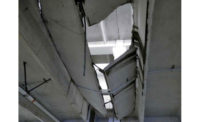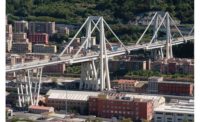Two separate failures of three cantilevered flanges of three precast, prestressed-concrete double-T parking-deck sections—reinforced with a non-code-compliant, high-strength carbon-fiber-reinforced polymer grid—are putting the spotlight on the structural safety of corrosion-resistant FRP grids for transverse reinforcement of double-Ts. The 2015 and 2016 collapses occurred in two garages at Harrah’s Cherokee Casino and Hotel, in Cherokee, N.C. In the second, there was injury to a vehicle and its driver.
The garage owner’s investigating engineer, also the engineer of record, has confirmed there are 100 FRP double-T garages on the East Coast and suspects the number is closer to 200. “This is a public safety issue,” says Jason Reigstad, project manager for Reigstad & Associates Inc., St. Paul, Minn. On the market for about eight years before the collapse, the grid is no longer marketed for this purpose, he adds.
The collapses on Feb. 19, 2015, and April 15, 2016, involved two ramps—the first in the six-level, 1,200-space hotel garage and the second in the eight-level, nearly 2,400-space casino garage. Completed in 2010, the structures are owned by the Tribal Casino Gaming Enterprise. TCGE is a tribal enterprise of the Eastern Band of the Cherokee Indians, according to two lawsuits filed in federal court—one for each incident—against the garages’ joint-venture contractors W.G. Yates & Sons Construction and Rentenbach Constructors Inc., the design-build garage subcontractor Metromont Corp. and the supplier of the FRP grid product, called C-Grid, Chomarat US Inc.
The dispute is currently in binding arbitration, says M. Aaron Lay, a partner of Hamilton Stephens Steele & Martin, who filed the lawsuit on behalf of TCGE in the U.S. District Court for the Western District of North Carolina. Combined repair and remediation costs, involving trenching in corrosion-resistant, stainless-steel bars in all the garage decks, are “in excess of $20 million,” says Lay.
Attempts to reach Chomarat failed. Yates passed requests for comment to Rentenbach, which “does not comment on pending arbitration cases,” says Donald W. Freeman, Rentenbach’s chairman emeritus. “We do believe the dispute resolution process will show that our joint-venture team properly executed its commitments.” Metromont Corp. also “does not comment on pending litigation,” says its lawyer, Harold C. Spears, of Caudle & Spears, Charlotte. “It expects to defend the suit successfully.”
On a hotel garage ramp, abutting cantilevered double-T flanges fractured along the stem and collapsed toward the level below when a recovery vehicle pulled out a sedan, says Reigstad. In the casino garage, one cantilevered flange failed as a Jeep Cherokee drove down a ramp.
Each failed double-T ramp section is 30 ft long and 13 ft, 4 in., wide and has two prestressed stems 3 ft, 7 in., in from each cantilevered flange, says Reigstad.
Typical deck double-Ts are 60 ft long. The hotel garage has 3.5-in.-deep decks; the casino has 4.75-in.-deep decks.
According to the complaint, the garages consist of “Metromont-manufactured precast, factory-topped CarbonCast” double-Ts. The C-Grid is in the flanges’ topping slab.
The complaints allege full-depth cracking of the double-Ts, premature deficiencies of the C-Grid, detachment of the C-Grid carbon fibers and premature deterioration and failure of the double-Ts.
The FRP reinforcing was underdesigned by “nearly a factor of four, if following the [American Concrete Institute FRP standard],” says Reigstad. Also, grid slab depth was not consistent throughout the garages, and the double-Ts’ midsection was effectively unreinforced concrete because the grid was not set deep enough into the slab, he adds.
The design was supposed to follow the codes, even though they do not apply to Indian territory. In any case, there is no code for this application, says Reigstad.
Carol Shield, a professor of engineering at the University of Minnesota and former chair of the American Concrete Institute’s ACI-440 technical committee on FRP reinforcement for concrete, confirms the grids are not in the standard. “There’s not even a standard for FRP reinforcing bars,” she says, adding that work on a draft standard is underway.









Post a comment to this article
Report Abusive Comment